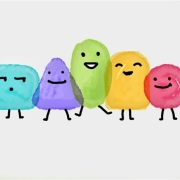5 Tips for Developing Flavors for Kids
You wouldn’t think it would be hard to develop foods and beverages for consumers who happily eat their own boogers. But, as every parent knows, kids can be the pickiest (no pun intended!) critics around.
But fear not! I’m here to share 5 tips and truths I’ve learned throughout my career that can help marketers master the art of developing flavors for kids.
1. Dare to Be Wild Mild
Look at the world of kids’ food and beverages and you’ll see a wealth of “extreme” type flavors. But the actual taste of these products is usually more mild than wild. That’s because kids want to feel bold and daring, but most actually prefer tamer flavors. (This is especially true for younger kids who aspire to be like their older siblings, many of whom are doing food dares and showing off their tolerance for things like WarHeads and Flamin’ Hot Cheetos.) Calling something “extreme” or “super sour” without going too far with the actual flavor helps kids feel older and cooler, while still enabling them to actually enjoy whatever they are consuming.
Even when it comes to “mystery” flavors, kids like the idea of being surprised, but they don’t want to be toosurprised—they want to have an inkling of what flavor to expect, or at least feel reassured that they will like it.
2. Keep It Simple
Yes, today’s kids have been exposed to more foods and flavors, and therefore have slightly more sophisticated palates than previous generations. (Many now eat foods like hummus, Greek yogurt, avocado and even sushi—things I never even knew existed when I was little.) But a majority still overwhelmingly gravitate towards the simple and familiar.
(When you think about it, even the way kids talk about flavors is simple—ask a kid what their favorite AirHeads is, and they’ll respond by naming a color—“I like blue best!”—instead of a flavor).
Most kids are turned off by flavors and ingredients they’ve never heard of. Similarly, products with too many ingredients or flavors can sound risky to their kid sensibilities. This is because kids can have a hard time wrapping their heads around how all the different things will taste together.
Additionally, the more ingredients or flavors a product has, the more likely they will find something that they don’t like. And most kids have a one-strike-and-you’re-out policy when it comes to undesirable flavors or ingredients. So, even if a product is packed with all of their favorite flavors, the presence of even just one thing they don’t like (or think that they won’t like) is enough to land that product firmly on the no-buy list.
One important note: the advice above pertains to single products with multiple ingredients/flavors mixed together. If you’re talking about a kit or mix, kids will gladly sort through lots of things they don’t like in order to eat what they really enjoy—M&Ms in trail mix, marshmallows in cereal or the dessert in a kids meal, for instance. (But it’s probably not wise to rely on this strategy—parents don’t appreciate wasting their money, so repeat purchase on products that are only partially consumed usually aren’t too promising.)
3. Remember, Digital Natives Love Analog Flavors
Kids love foods and drinks that taste like… other foods and drinks. Pizza flavored potato chips? PB&J granola bars? Cupcake yogurt? Yum, yum and yum. Promising to deliver flavors that taste like their familiar favorites is both exciting and reassuring. And most of the time, the flavors don’t even have to taste super close to the real thing. So, if you’re looking for an easy way to tempt kids’ tastebuds and give them an understanding of the flavors they can expect, then you may want to turn to some of their all-time favorites for inspiration.
4. Caution: Age Differences Are Bigger Than They Appear
If you think about it, a 10-year-old is 30% older than a 7-year-old, so a few years can make a big difference in the life of a kid. This doesn’t necessarily mean that your product can’t capture the hearts and mouths of a decent-sized age range, but it does mean that you should aim for the higher ages in your target to do so.
When developing flavors—or at least the names and graphics used to communicate them—remember that younger kids always aspire to be older and older kids never want to be seen as being babyish. This means you’ll have a much better chance getting a younger kid to drink something with an aged-up flavor that appeals to older kids (like Maxed Out Mixed Berry) than getting an older kid to drink something that sounds like it’s made for little kids (like Mixed Berry Merry-Go-Round / Triple Berry Teddy Bear).
5. Dip, Dunk and Drizzle Your Way to Kid Acceptance
Lots of brands are looking to create better-for-you products for kids, but getting young tastebuds to accept them can be easier said than done. One reliable solution is to pair the healthier offering with a dip or topping that kids love. Many kids are more willing to eat fruits when they can dunk them in Nutella or veggies when they can pour on some cheese or ranch dressing. And parents are often willing to overlook the dips and toppings if it means their kids will eat something they want them to have. (As an added bonus, dipping, dunking and drizzling also delivers on kids’ love of customization and interactivity.)
Do you need help developing or positioning a new kid or young family-targeted product? Feel free to reach out—I’d love to hear about your opportunity and discuss how Seed can help. And be sure to subscribe to The Accelerator and stay tuned for more articles on how to innovate and market to today’s kids and young families.
Adam Siegel is the Editor of The Accelerator and VP, Creative at Seed Strategy where he draws upon his 20+ years researching, advertising and creating new products for kids to help clients win in the youth and young family market.
Connect with us! Follow Seed Strategy on our LinkedIn, Twitter, Facebook and Instagram pages.






Trackbacks & Pingbacks
[…] 5 Tips for Developing Flavors for Kids […]
Comments are closed.